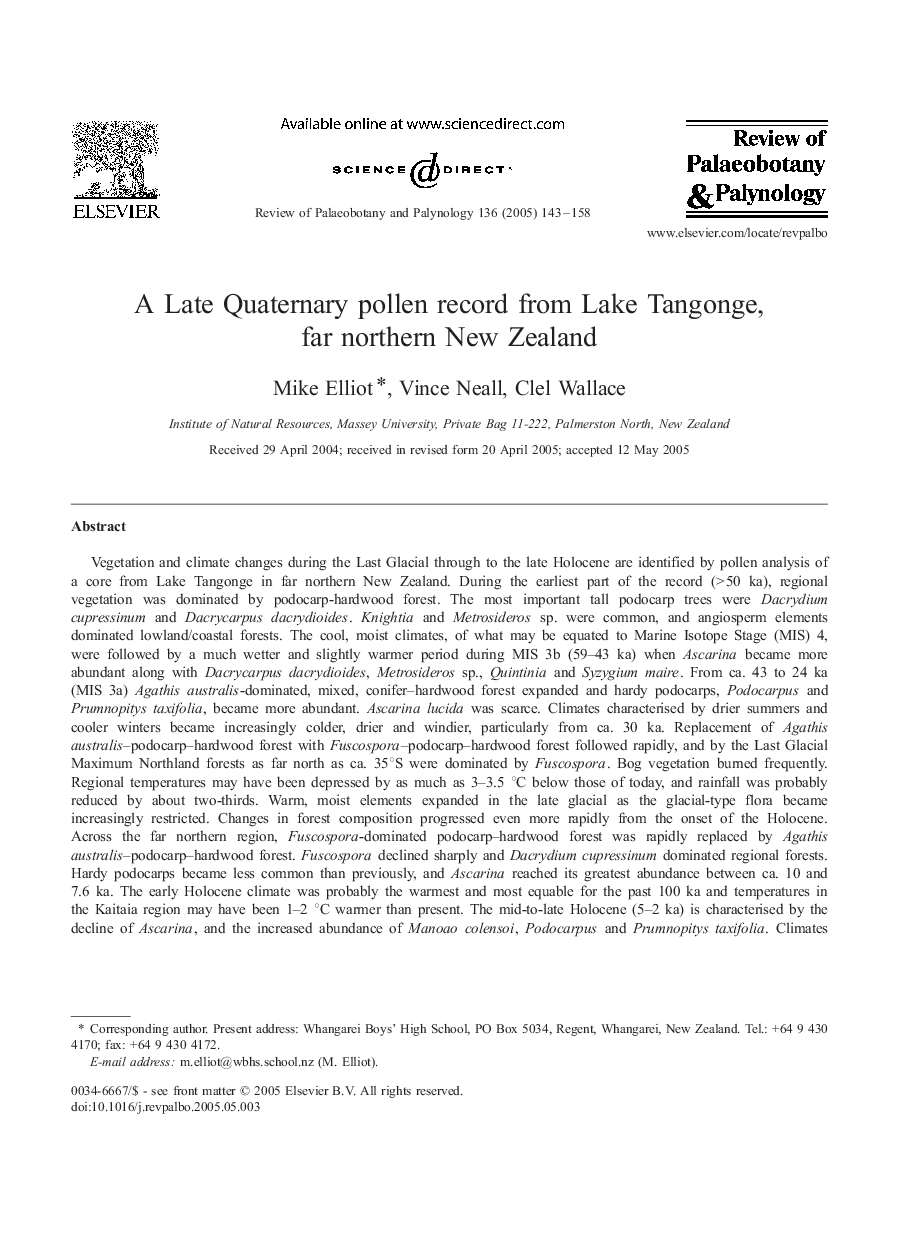| کد مقاله | کد نشریه | سال انتشار | مقاله انگلیسی | نسخه تمام متن |
|---|---|---|---|---|
| 10122046 | 1642590 | 2005 | 16 صفحه PDF | دانلود رایگان |
عنوان انگلیسی مقاله ISI
A Late Quaternary pollen record from Lake Tangonge, far northern New Zealand
دانلود مقاله + سفارش ترجمه
دانلود مقاله ISI انگلیسی
رایگان برای ایرانیان
کلمات کلیدی
موضوعات مرتبط
مهندسی و علوم پایه
علوم زمین و سیارات
فسیل شناسی
پیش نمایش صفحه اول مقاله

چکیده انگلیسی
Vegetation and climate changes during the Last Glacial through to the late Holocene are identified by pollen analysis of a core from Lake Tangonge in far northern New Zealand. During the earliest part of the record (> 50 ka), regional vegetation was dominated by podocarp-hardwood forest. The most important tall podocarp trees were Dacrydium cupressinum and Dacrycarpus dacrydioides. Knightia and Metrosideros sp. were common, and angiosperm elements dominated lowland/coastal forests. The cool, moist climates, of what may be equated to Marine Isotope Stage (MIS) 4, were followed by a much wetter and slightly warmer period during MIS 3b (59-43 ka) when Ascarina became more abundant along with Dacrycarpus dacrydioides, Metrosideros sp., Quintinia and Syzygium maire. From ca. 43 to 24 ka (MIS 3a) Agathis australis-dominated, mixed, conifer-hardwood forest expanded and hardy podocarps, Podocarpus and Prumnopitys taxifolia, became more abundant. Ascarina lucida was scarce. Climates characterised by drier summers and cooler winters became increasingly colder, drier and windier, particularly from ca. 30 ka. Replacement of Agathis australis-podocarp-hardwood forest with Fuscospora-podocarp-hardwood forest followed rapidly, and by the Last Glacial Maximum Northland forests as far north as ca. 35°S were dominated by Fuscospora. Bog vegetation burned frequently. Regional temperatures may have been depressed by as much as 3-3.5 °C below those of today, and rainfall was probably reduced by about two-thirds. Warm, moist elements expanded in the late glacial as the glacial-type flora became increasingly restricted. Changes in forest composition progressed even more rapidly from the onset of the Holocene. Across the far northern region, Fuscospora-dominated podocarp-hardwood forest was rapidly replaced by Agathis australis-podocarp-hardwood forest. Fuscospora declined sharply and Dacrydium cupressinum dominated regional forests. Hardy podocarps became less common than previously, and Ascarina reached its greatest abundance between ca. 10 and 7.6 ka. The early Holocene climate was probably the warmest and most equable for the past 100 ka and temperatures in the Kaitaia region may have been 1-2 °C warmer than present. The mid-to-late Holocene (5-2 ka) is characterised by the decline of Ascarina, and the increased abundance of Manoao colensoi, Podocarpus and Prumnopitys taxifolia. Climates were probably slightly cooler and drier during this time as a more seasonal, dry summer/wet, cool winter regime prevailed. Increased cyclonic activity is suggested during this time.
ناشر
Database: Elsevier - ScienceDirect (ساینس دایرکت)
Journal: Review of Palaeobotany and Palynology - Volume 136, Issues 3â4, October 2005, Pages 143-158
Journal: Review of Palaeobotany and Palynology - Volume 136, Issues 3â4, October 2005, Pages 143-158
نویسندگان
Mike Elliot, Vince Neall, Clel Wallace,